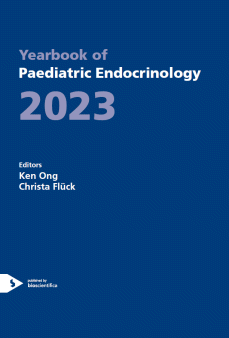5. Puberty
Clinical Guidance and Studies
ey0020.5-1 | Clinical Guidance and Studies | ESPEYB20
5.1. Leuprolide and triptorelin treatment in children with idiopathic central precocious puberty: an efficacy/tolerability comparison study
M Valenzise , C Nasso , A Scarfone , M Rottura , G Cafarella , G Pallio , G Visalli , E Di Prima , E Nasso , V Squadrito , M Wasniewska , P Irrera , V Arcoraci , F Squadrito
ey0020.5-2 | Clinical Guidance and Studies | ESPEYB20
5.2. Timing of puberty in relation to semen characteristics, testicular volume, and reproductive hormones: a cohort study
N Brix , A Gaml-Sorensen , A Ernst , LH Arendt , LL Harrits Lunddorf , G Toft , SS Tottenborg , KK Haervig , BB Hoyer , KS Hougaard , JPE Bonde , CH Ramlau-Hansen
ey0020.5-3 | Clinical Guidance and Studies | ESPEYB20
5.3. Pre-pubertal accelerometer-assessed physical activity and timing of puberty in British boys and girls: the Millennium Cohort Study
TS Cheng , S Brage , EMF van Sluijs , KK Ong
ey0020.5-4 | Clinical Guidance and Studies | ESPEYB20
5.4. Reproductive markers of testicular function and size during puberty in boys with and without a history of cryptorchidism
W Rodprasert , JJ Koskenniemi , HE Virtanen , S Sadov , A Perheentupa , H Ollila , J Albrethsen , A-M Andersson , A Juul , NE Skakkebaek , KM Main , J Toppari
ey0020.5-5 | Clinical Guidance and Studies | ESPEYB20
5.5. AMH concentrations in infancy and mid-childhood predict ovarian activity in adolescence: a long-term longitudinal study of healthy girls
CP Hagen , MB Fischer , C Wohlfahrt-Veje , M Assens , AS Busch , AT Pedersen , A Juul , KM Main
ey0020.5-6 | Clinical Guidance and Studies | ESPEYB20
5.6. Neuroimaging in 205 consecutive children diagnosed with central precocious puberty in Denmark
AB Hansen , CH Renault , D Wojdemann , P Gideon , A Juul , RB Jensen
ey0020.5-7 | Clinical Guidance and Studies | ESPEYB20
5.7. An increasing tendency of precocious puberty among Korean children from the perspective of COVID-19 pandemic effect
ey0020.5-8 | Clinical Guidance and Studies | ESPEYB20
5.8. GnRH replacement rescues cognition in Down syndrome
M Manfredi-Lozano , V Leysen , M Adamo , I Paiva , R Rovera , JM Pignat , FE Timzoura , M Candlish , S Eddarkaoui , SA Malone , MSB Silva , S Trova , M Imbernon , L Decoster , L Cotellessa , M Tena-Sempere , M Claret , A Paoloni-Giacobino , D Plassard , E Paccou , N Vionnet , J Acierno , AM Maceski , A Lutti , F Pfrieger , S Rasika , F Santoni , U Boehm , P Ciofi , L Buee , N Haddjeri , AL Boutillier , J Kuhle , A Messina , B Draganski , P Giacobini , N Pitteloud , V Prevot




